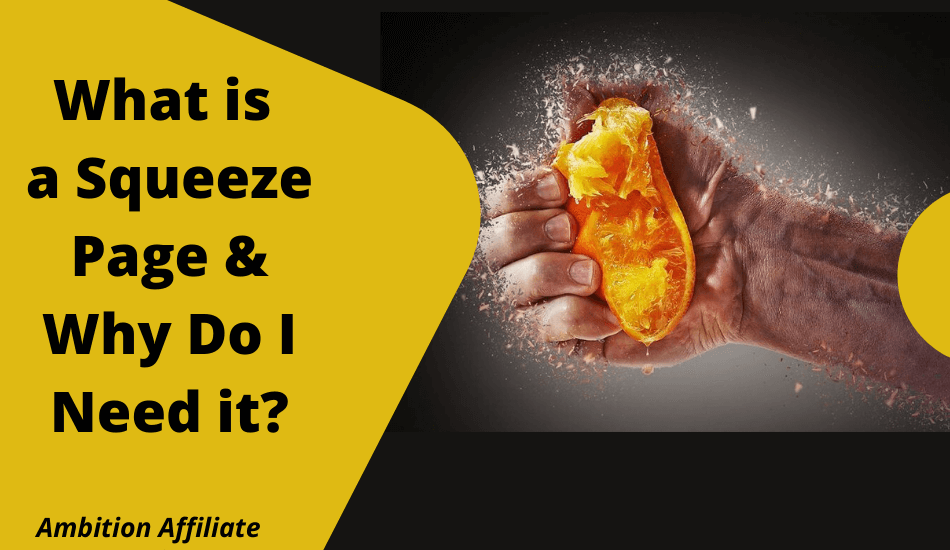In the world of pages and funnels, you’ve probably heard of a squeeze page and then equated it with a landing page. It turns out it’s not the same. But to complicate things a bit, a squeeze page is actually a landing page.
Yes, we know it’s all very confusing… along with all the other jargon in the world of online marketing. But it really doesn’t have to be, and that’s why we’re going to break down the purpose and usage for these two types of website pages.
Table of Contents
Squeeze page vs. landing page
Squeeze pages and landing pages are equally important pages to use when building a website. They are an integral part of running an online business and running a successful internet marketing campaign. And that’s mainly because you can better engage your audience and convert directly if you use the right page type. It’s really easy. You want to use the most effective medium to get your message across.
So while it’s just terminology, you’ll surely want to take a moment to fully understand it. And distinguishing them can be very difficult, even for some seasoned experts, since both serve the same purpose: gathering user information.
Both pages focus on getting users to fill out a form to collect their name and email addresses, but a landing page will contain various elements that provide further explanation of product information, while a squeeze page will more focus on gathering user information. It’s good to know that, all squeeze pages are landing pages, but landing pages aren’t always squeeze pages.
What is the purpose of a squeeze page?
If you want to create a page for your website that focuses on a single offer, then a squeeze page is probably for you. It’s usually the first page a visitor lands on after clicking your ad.
In terms of content, a squeeze page is at its best when it is presented in a clean, clear, and concise manner. The simpler the better, if you will. It must have a consistent look and feel with the rest of your brand, e.g. Easily recognizable colors and logos, but the page itself must not contain lengthy content or even additional links – all of which will distract and possibly redirect visitors away from your site.
From a user experience perspective, you want to make sure that a visitor feels compelled to enter their name and email address in the page form almost immediately. More difficult than it sounds, we know. But that’s the main goal of a squeeze page, to “squeeze” or solicit email addresses from prospects.
The most common way to do this is by offering a freebie in exchange for something of high perceived value, such as an e-book. The freebie itself should address a pain point that you already know your audience has, that your product/company can ultimately solve if you retarget in future campaigns.
The purpose of a squeeze page is to “squeeze” information out of the visitor, but why? To add them as a contact to your email list. A well-designed squeeze page is an essential part of a good list-building and lead generation strategy.
In terms of design concepts, a squeeze page is quite similar to a landing page, as both must feature an engaging headline and a strong call-to-action.
But the difference is in the copy. A squeeze page is usually just a few short bullet points. The copy is tighter and more direct.
A squeeze page also doesn’t have any additional distractions like menu navigation options or links to improve the chances of the visitor filling out the opt-in form. Check out and click through this webpage that successfully follows the textbook formula for a high-converting squeeze page example from Marie Forleo:

What can I expect from a squeeze page?
Assuming you’re new to digital marketing, you might be surprised to learn that the average conversion rate of a squeeze page is around 2%.
Don’t let that number discourage you, as only 2% can still be very effective if you have a stellar funnel to nurture your leads and close sales. There are also some tips and tricks to help you optimize your funnel and increase your conversion rate as the best squeeze page strategies have a conversion rate of 3-5 times the average. We will list some of these tips at the end!
Another useful thing to keep in mind is that it really isn’t always about quantity. Yes, of course, you want as many people as possible to sign up to subscribe to your list, but more specifically, you want as many of your ideal customers as possible to sign up.
Numbers aren’t the only goal, so redirect some of your focus to optimizing your content, and that will increase your chances of quality conversions – leading to better-qualified prospects in your funnel. Every marketer’s dream!
Why use a squeeze page?
As a company, you have specific business goals that you want to achieve with your marketing efforts. Adding a squeeze page to your website becomes :
- Attract potential customers to your website
- Add contacts to your email list
- Convert website visitors into paying customers
Both a squeeze page and a landing page can achieve all three of these goals, but if your primary goal is to collect names and email addresses for future campaigns, a squeeze page is best. However, if you want to create a page to make a sale, a landing page would be best.
What is the best way to optimize my squeeze page?
The fastest way to create a powerful squeeze page is to replicate one you already have! Rest assured that we do not encourage blatant copying and stealing of intellectual property, but there is nothing to stop you from using other sites as inspiration for your own.
Reverse engineering the process. Look at each element on the page, the headline, the images, the font, the text, the design, and customize these elements by customizing them to your own squeeze page.
You should also pay attention to this:
- The headline. Make sure you have an attention-grabbing headline, and also make sure the image complements the headline.
- The subheading. Use social proof and talk about the value proposition to attract readers.
- The copy. Avoid redundancies by keeping the copy clear and concise. Use bullet points.
- The CTA button. Both the button color and the text are important. Make sure the color contrasts with the page and the text is exciting!
Conclusion
In summary, a squeeze page and landing page are similar in design principles and usage, but a squeeze page has slightly different elements to capture user information more directly. This can be confusing, but ultimately it’s all about choosing the most appropriate page for the highest possible conversion. There are also additional steps you can take to increase your conversion rate by an average of 2%.
If you want visitors to focus only on exchanging their information for a single product offering, usually a giveaway, then a squeeze page is the best choice between the two-page types.



